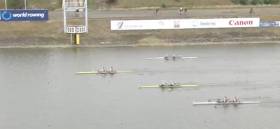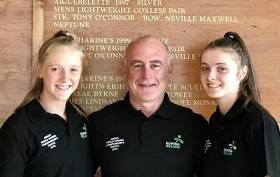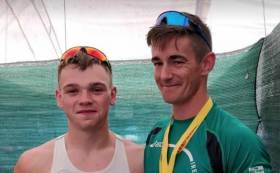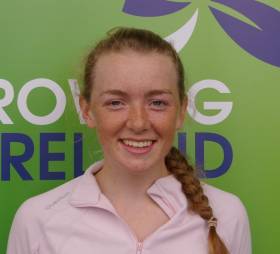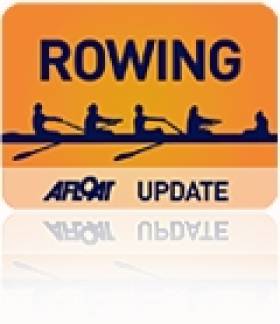Displaying items by tag: World Junior Championships
Moynihan and Browne Miss Out in Close Race at World Junior Rowing
#Rowing: Ireland’s Ciara Moynihan and Ciara Browne finished third in their repechage of the junior women’s double at the World Junior Championships in Racice this morning. There were two spots available in the A/B semi-final, and Britain and Japan held them as the crews passed the 1750 metre marker. Moynihan and Browne sprinted hard to the line but could not quite catch second-placed Japan.
The Ireland double’s time would have put them through in two of the other three repechages. They go on to the C/D semi-finals.
The Ireland pair of Eliza O’Reilly and Gill McGirr qualified for the A/B semi-finals, while the men’s quadruple also face into C/D semi-finals.
World Junior Rowing Championships, Racice, Czech Republic (Selected Results)
Men
Quadruple – Repechage Two (First Two to A/B Semi-Finals; rest to C/D Semi-Finals): 1 Denmark 5:52.45, 2 Chile 5:56.25, 3 Ireland (L Hayes Nally, A Byrne, J Dorney, J Keating) 5:58.73.
Women
Pair – Repechage (First Three to A/B Semi-Final; rest to C Final): 1 France 7:25.97, 2 Hungary 7:29.32, 3 Ireland (E O’Reilly, G McGirr) 7:31.49.
Double – Repechage Four (First Two to A/B Semi-Finals; rest to C/D Semi-Finals): 1 Britain 7:12.35, 2 Japan 7:14.36; 3 Ireland (C Moynihan, C Browne) 7:15.23.
Ireland Denied as Denmark Set New World Junior Championships Record
#Rowing: Ireland just missed out on a place in the A/B semi-finals of the junior men’s quadruple at the World Junior Championships in Racice, Czech Republic. The crew of Luke Hayes Nally, Alex Byrne, Jack Dorney and Jack Keating finished third to Denmark and Chile, with just two boats going on; the race was fast, setting a new record for this event at a World Junior Championships.
Chile had led through most of the race, with Denmark never far away. Ireland moved into a clear third place. In the final 300 metres Denmark charged into the lead and flew away from Chile. Ireland did their best to catch Chile, but the South Americans kept their nerve well and held on to the crucial second spot by a length.
Ireland go to the C/D Semi-Finals. Earlier the women's junior pair of Eliza O'Reilly and Gill McGirr had qualified for the A/B Semi-Finals.
World Junior Rowing Championships, Racice, Czech Republic (Selected Results)
Men
Quadruple – Repechage Two (First Two to A/B Semi-Finals; rest to C/D Semi-Finals): 1 Denmark 5:52.45, 2 Chile 5:56.25; 3 Ireland (L Hayes Nally, A Byrne, J Dorney, J Keating) 5:58.73.
Women
Pair – Repechage (First Three to A/B Semi-Final; rest to C Final): 1 France 7:25.97, 2 Hungary 7:29.32, 3 Ireland (E O’Reilly, G McGirr) 7:31.49.
#Rowing: Ireland’s junior men’s quadruple took fourth in their heat and the junior women’s double fifth at the World Junior Championships at Racice in the Czech Republic.
Two boats qualified for the semi-finals from the heats of the quadruple, and Switzerland, New Zealand and Italy vied for these places in the second half of the race, with Italy missing out. Ireland were next in line.
Greece were convincing winners of their heat of the women’s double, grabbing hold of the one semi-final place on offer. Ciara Moynihan and Ciara Browne held fifth through the race.
Earlier, the Ireland junior men’s coxed four qualified from their heat. The junior women’s pair took fourth and face into a repechage.
The schedule was brought forward and races run at five-minute intervals because of the forecast of very high temperatures in the middle of the day.
World Junior Championships, Racice, Czech Republic (Irish interest)
Men
Four, coxed – Heat One (First Three to A/B Semi-Finals; rest to Repechage): 2 Ireland (C Mulready, J O’Donovan, F Driscoll, E Gaffney; cox: E Finnegan) 6:39.91.
Quadruple – Heat One (First Two to A/B Semi-Finals; rest to Repechage): 3 Ireland (L Hayes Nally, A Byrne, J Dorney, J Keating) 6:13.31.
Women
Pair – Heat Three (First Three to A/B Semi-Finals; rest to Repechage): 4 Ireland (G McGirr, E O’Reilly) 7:54.87
Double – Heat Two (First to A/B Semi-Final; rest to Repechage): 5 Ireland (C Moynihan, C Browne) 7:47.20.
#Rowing: Ireland had a good start to their campaign in the World Junior Championships. The Ireland coxed four of Conor Mulready, James O’Donovan, Fintan O’Driscoll, Eoin Gaffney and cox Eoin Finnegan took a good second place in their heat, comfortably qualifying for their semi-finals as the second of three qualifiers. Canada won and Russia came through in third.
In the women’s junior pair, Gill McGirr and Eliza O’Reilly took fourth in their heat and will face into a repechage. The United States won – by an extraordinary margin – from Canada, while Britain came through in their own battle for third with Ireland.
World Junior Championships, Racice, Czech Republic (Irish interest)
Men
Four, coxed – Heat One (First Three to A/B Semi-Finals; rest to Repechage): 2 Ireland (C Mulready, J O’Donovan, F Driscoll, E Gaffney; cox: E Finnegan) 6:39.91.
Women
Pair – Heat Three (First Three to A/B Semi-Finals; rest to Repechage): 4 Ireland (G McGirr, E O’Reilly) 7:54.87
#Canoeing: Ronan Foley won the B Final of the Junior K1 1,000 metres at the Canoe Sprint World Junior and Under-23 Championships in Plovdiv, Bulgaria, today. The Kilcullen man had over two seconds to spare over his nearest rival, Philip Miles of Britain. The win places him 10th overall.
Just three weeks ago, Foley took gold in the canoe marathon European Championships in Croatia.
Canoe Sprint World Junior Championships, Plovdiv, Bulgaria
Junior K1 1,000 – B Final (Places 10 to 18): 1 Ireland (R Foley) 3 min 38.463 sec.
#Rowing: Ireland’s double of Margaret Cremen and Aoife Casey won their B Final this morning at the World Rowing Junior Championships in Trakai, Lithuania. The race developed very early into a battle between France and Ireland, with Ireland less than a boat length ahead for much of the 2,000 metres. In the sprint finish, France could not overtake the Irish women.
The result places Ireland seventh overall of the 28 crews which started.
World Junior Championships, Day Five, Irish interest
Women
Junior Double Sculls – B Final (Places 7 to 12): 1 Ireland (A Casey, M Cremen) 7:38.31, 2 France 7:39.65, 3 Netherlands 7:42.20, 4 Ukraine 7:42.25, 5 Japan 7:42.85, 6 Greece 7:44.73.
#Rowing: Ireland’s Aoife Casey and Margaret Cremen will compete in the B Final of the women’s double at the World Rowing Junior Championships in Trakai, Lithuania. In this morning’s semi-final, the Skibbereen/Lee crew took fourth, just under two seconds behind Chile, who took the third qualification spot. Britain were impressive winners, ahead of Italy. Ireland took over in fourth in the second half of the race, but while they finished fast, they could not force themselves in the trio which qualified for the A Final.
World Junior Championships, Day Four (Irish interest)
Women
Junior Double – Semi-Final Two (First Three to A Final; rest to B Final): 1 Britain 7:21.24, 2 Italy 7:25.05, 3 Chile 7:27.62; 4 Ireland (A Casey, M Cremen) 7:29.61, 5 France 7:30.71, 6 Netherlands 7:31.93.
#Rowing: Ireland have qualified for the semi-finals of the women’s double sculls at the World Rowing Junior Championships in Trakai, Lithuania. Aoife Casey and Margaret Cremen finished third in their quarter-final. Canada, who led from the early stages, won well. Ireland had tracked them, holding second from before halfway until the final stages when the Netherlands got ahead of them.
World Rowing Junior Championships, Trakai, Lithuania, Day Three (Irish interest)
Women
Double Sculls – Quarter-Final Three (First Three to A/B Semi-Finals; rest to C/D Semi-Finals): 1 Canada 7:23.78, 2 Netherlands 7:29.52, 3 Ireland (A Casey, M Cremen) 7:30.27; 4 Austria 7:33.56, 5 New Zealand 7:36.51, 6 Estonia 7:52.65.
Ireland's Casey and Cremen Progress at World Junior Rowing
#Rowing: Ireland’s Aoife Casey and Margaret Cremen took third in their heat and qualified for the quarter-finals of the World Junior Championships in Trakai in Lithuania today. The Skibbereen/Lee double had tucked into third behind Britain, who won, and Germany by halfway. Ukraine and Belarus fought to take the fourth qualification spot, with Ukraine coming out on top.
World Junior Championships, Trakai, Lithuania, Day One (Irish interest)
Women
Junior Double Sculls – Heat Two (First Four to Quarter-Finals; rest to Repechage): 1 Britain 7:08.82, 2 Germany 7:12.30, 3 Ireland (A Casey, M Cremen) 7:16.58, 4 Ukraine 7:18.06.
Fast-Finishing Australia and Germany Push Ireland Into B Final
#WorldJuniorRowing: Ireland’s Bridget Jacques and Hilary Shinnick missed out on the A Final of the women’s double sculls at the World Junior Championships at Trakai in Lithuania.
The first three from today’s A/B semi-final made it into tomorrow’s A Final, and Romania took the most direct route, leading down the course to win. Behind them an exciting battle unfolded. Through the second half of the race, Germany, Ireland and Australia effectively competed for two places. At 1500 metres, Germany held second and Australia third, clear of Ireland. Australia upped the ante and closed up on Germany, and while the Ireland crew pushed hard in the closing stages they couldn’t head either of their rivals. Australia passed Germany to take second. Ireland finished 2.8 seconds down on Germany in fourth. They are set to compete in tomorrow’s B Final.
World Junior Rowing Championships, Trakai, Lithuania, Day Four (Selected Results, Irish interest)
Men
Quadruple Sculls– C/D Semi-Final One (First Three to C Final; rest to D Final): 1 Romania 6:15.90, 2 Ukraine 6:17.57, 3 Ireland (C Carmody, J Mitchell, D O’Malley, P Hegarty) 6:18.28, 4 Russia 6:22.38, 5 Estonia 6:29.19.
Double Sculls – Semi-Final One (First Three to C Final; rest to D Final): 1 France 6:49.57, 2 Russia 6:50.65, 3 United States 6:50.83; 4 Ireland (A Harrington, J Casey) 6:51.05, 5 Bulgaria 6:59.84, 6 Estonia 7:06.97.
Women
Quadruple Sculls – C Final (places 13 to 17): 1 Estonia 7:07.80, 2 Japan 7:10.80, 3 Denmark 7:12.25, 4 Sweden 7:12.30,
5 Ireland (F Murtagh, J English, E Barry, B Walsh) 7:25.01.
Double Sculls – A/B Semi-Final One (First Three to A Final; rest to B Final): 1 Romania 7:21.16, 2 Australia 7:25.43, 3 Germany 7:26.07; 4 Ireland (H Shinnick, B Jacques) 7:28.15, 5 Croatia 7:32.84, 6 Slovenia 7:46.21.



























